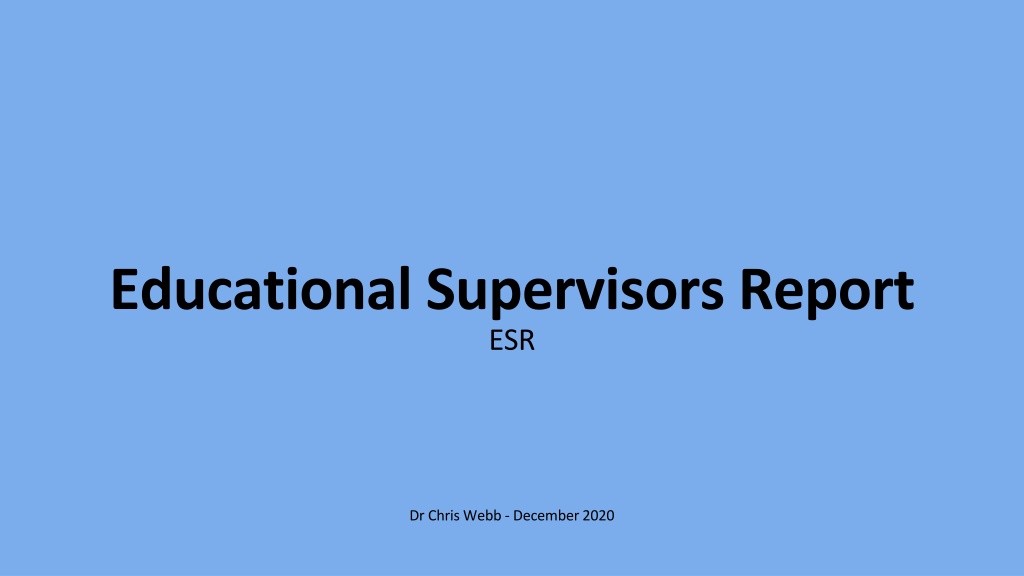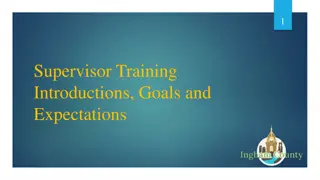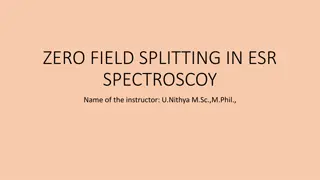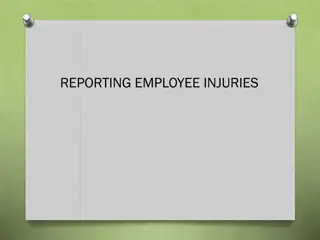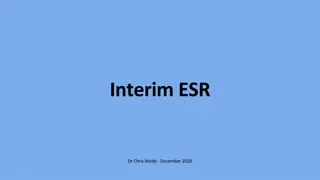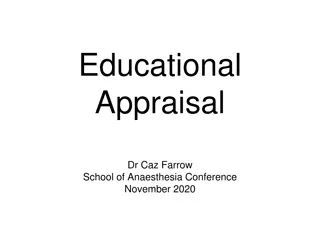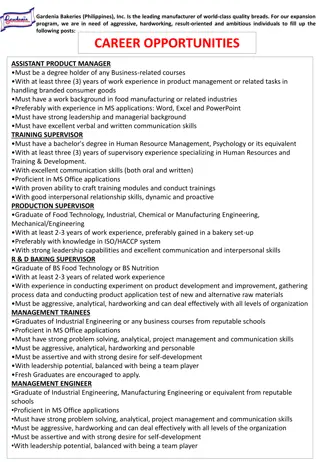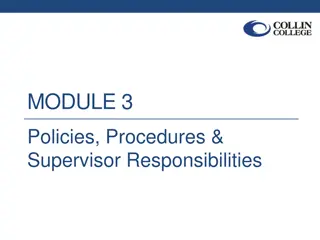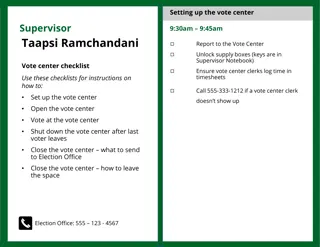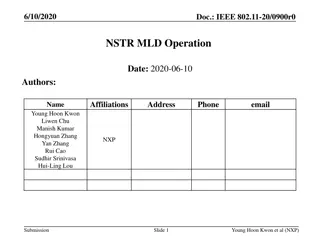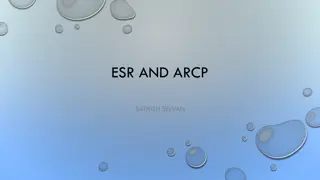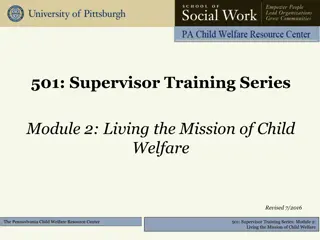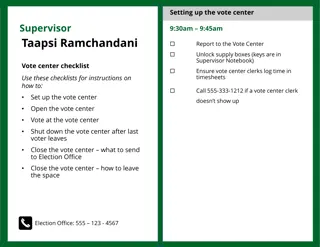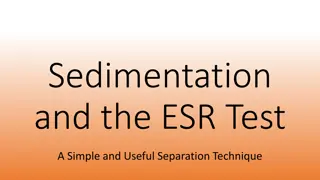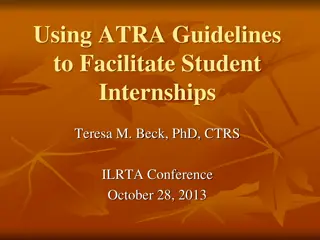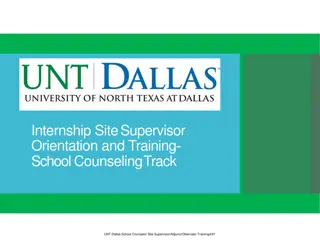Understanding the Educational Supervisor Review (ESR) Process in Medical Training
The Educational Supervisor Review (ESR) is a crucial part of medical training mandated by the GMC to assess trainees' progress, provide feedback, and identify training needs. Conducted every six months, ESRs involve assessing capabilities, building a rich evidence portfolio, and informing decisions on trainee competence for licensing. The process ensures regular engagement with evidence in the Trainee ePortfolio, leading to the formation of learning plans and recommendations for further training.
Download Presentation

Please find below an Image/Link to download the presentation.
The content on the website is provided AS IS for your information and personal use only. It may not be sold, licensed, or shared on other websites without obtaining consent from the author. Download presentation by click this link. If you encounter any issues during the download, it is possible that the publisher has removed the file from their server.
E N D
Presentation Transcript
Educational Supervisors Report ESR Dr Chris Webb - December 2020
The GMC have mandated that all trainees are required to have an annual Educational Supervisor Review (ESR). This is irrespective of whether they are full time or in a less than full time rotation. WPBA builds up a qualitative picture of their performance in training. They are responsible for monitoring the evidence they collect in their Portfolio to ensure they are completing their assessments in a timely fashion, covering the Capabilities and Clinical Experience Groups, and keeping up to date with their mandatory training requirements
Purpose of the ESR ESRs provide feedback on the trainee s overall progress and identifies areas where they need more focused training Reviews are informed by the evidence they collect through the WPBA tools, along with naturally occurring evidence from elsewhere in the Trainee ePortfolio (for example, the Learning Log) They then agree a learning plan, and the outcome of the review will be recorded in their Trainee ePortfolio. The educational supervisor decides whether their progress is satisfactory, unsatisfactory or needs to be referred to the ARCP panel Towards the end of training there s a final review, and the educational supervisor makes a recommendation to the deanery ARCP panel regarding their overall capability. The ARCP panel makes the final judgement on whether they re competent for licensing, based on the evidence in the ESR and their Trainee ePortfolio as a whole
Frequency of ESR An ESR is conducted every six calendar months, whether training full-time or not. Reviews are carried out even if they do not coincide exactly with the end of posts. This ensures regular feedback and engagement with the evidence in the Trainee ePortfolio, and means that the ARCP panel has a recent ESR to inform their decision making Review meetings usually take between one and two hours, followed by a write-up in the ePortfolio
Capability progression in ESR For the six-monthly reviews, the trainee first conducts a self-assessment of their progress on the 13 capabilities. They are then assessed by the educational supervisor Quality of evidence is more important than quantity. In the early stages of training, it s unlikely that they ll be able to provide evidence of readiness to practise. But the review will form the basis of a learning plan, highlighting where they re doing well and where more support is needed By the end of ST3, the educational supervisor will be looking to establish fitness to practise through several sets of evidence in each capability area, collected from a range of settings and through different tools. Each portfolio will look slightly different, but it should provide a rich picture built up over three years
Clinical experience groups coverage in ESR While it s not the main focus of ESR, the trainee has opportunities to consider breadth of clinical experience groups coverage as well as progress in the capabilities When reviewing their Trainee ePortfolio, the trainee and their educational supervisor can monitor how far they re covering the range of knowledge described in the curriculum, in preparation for the Applied Knowledge Test (AKT) and clinical practice
Completing trainee self-rating and educational supervisor capability grading for ESR
Capability For each capability the list of linked evidence should be reviewed These can be opened and reviewed by clicking on them For each capability area the trainee is required to pick 3 pieces of evidence, from the range available, which most accurately gives the summary of their current performance in that capability area It is preferable that a range of types of evidence from logs and assessments (CbDs, CSR etc) is selected, though often logs alone may be used if these demonstrate a range of the descriptors Using the capability descriptors, the trainee states what these pieces of evidence show them doing and how they support the grade they have given. They should only comment on evidence within the portfolio not their opinion of anything that is not recorded
Capability ...Continued As an ST1/2 it would be expected that they would be meeting the Needs Further Development NFD descriptors but may also have some showing competent NFD- BE (Below Expectations) - may be picked if the evidence used show poor performance or elements of the Indicators of Potential Underperformance IPUs or if the quantity or quantity of evidence is so poor that it is not possible to grade any higher NFD- ME (Meets Expectation) - may be picked if the trainee is demonstrating many of the elements of NFD in the capability descriptors, with several pieces of evidence supporting this NFD- AE (Above Expectation) - may be used if the evidence cited demonstrates some of the Competent capability descriptors and there is a good amount of good quality evidence linked.
Capability ...Continued For the pre ARCP ESR evidence from any time in that year, even if it does not appear in this review, can be cited. E.g log entry 20.3.19 DVT entry shows me using a stepwise approach, basing further enquiries, examinations and tests on what is already known and what is later discovered as having calculated a Wells score I did an in- house D dimer and then referred the patient for an US scan of the leg. This is in the excellent descriptors and would be evidence of NFD-AE for a pre final ESR trainee or Competent or excellent for a ST3 completing their final ESR The ES or CS may have stated, in the log comments or assessments feedback, why they were linking the log to set capabilities or grading the assessment as they did and if they have done this, quoting the capability descriptors, their comments can be copy and pasted into the self-assessment. Trainees being clear in their log which of the capabilities they feel they are addressing makes this more likely and as a result commenting on evidence is much easier and quicker in the ESR In order to have a good range of evidence to use it is important that all of the capabilities have at least one log linked to it in the review period. More logs allow for more of the capability descriptors to be evidenced and a higher grade awarded It is important to demonstrate the capabilities across the range of Clinical experience groups but not all have to be demonstrated in each one. How many is possible will depend of the post under review
Examples ST3 final ESR
Action plans After completing the capability grading the trainee will be asked to pick up to 3 capabilities that they feel they need to focus most on developing in the next review period For each of these they need to write what they aim to achieve, ideally relating to the capability descriptors The ES may add a further two of these if the trainee has not selected a capability that they feel is important for the trainee to address This is required even for final review ST3/4s as they need to plan further development in their post CCT pre-appraisal period
Examples ST3
Educational Supervisor The Educational supervisor should read the trainee self-rating and review the evidence they have linked and decide if they feel that this does support the grade given They also need to decide if this is a true representation of the trainees current level as demonstrated within the portfolio To do this they need to be aware of or review all the linked evidence If the trainee has clearly stated what the evidence shows and how, using the capability descriptors, they are able to justify the grade and the evidence linked supports this, the ES can simply agree, stating that they have confirmed this to be correct If however there is evidence that they feel supports a lower grade they need to link this evidence and state why this supports a lower grade. Similarly, if they feel that the trainee level is higher than they have graded themselves they justify this different grade using linked evidence and stating how this supports this revised grade They are able to link up to an additional 3 pieces of evidence
Examples Example of agreeing with grade trainee has given:
PDP review Reviewing the PDP and helping the trainee write SMART entries is an important part of the ESR meeting and review Before each placement/post, as well as during it, trainees should think about what their learning needs are, relevant to that post and how to address these. For ST1s this can be done before or at their initial meeting with their ES and subsequently when completing their self-assessment review for their ESR. Trainees should propose at least one PDP entry that covers a learning need and make a SMART plan for achieving this. At the ESR the trainer can edit this/these and also help the trainee create other relevant ones if needed PDPs are focusing on specific topic, skills or learning needs that the next post will require and help them achieve. They may well be about specific parts of the GP curriculum and are separate to the actions plans which focus on demonstrating progression in the capabilities
